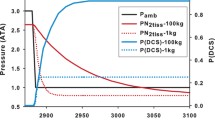Abstract
Decompression illness and decompression sickness are pathologies mostly associated with diving incidents, which result from excessive bubble formation from dissolved gas. Great efforts are undertaken to perform research to understand the pathology and fundamental mechanisms, which result from the dynamic effects of compression and decompression. In this chapter, the clinical manifestation of decompression illness including the impact on different physiological systems is presented. Principles in physics, chemistry and biology are investigated that build the base to understand the mechanisms of decompression and bubble kinetics. These principles are then used to derive algorithms and concepts to calculate decompression schedules, which aim to safely step the diver back to the surface. Different approaches are dissected for their general ideas and implementation.
Access this chapter
Tax calculation will be finalised at checkout
Purchases are for personal use only
Similar content being viewed by others
References
Vann R.D., Butler F.K., Mitchell, S.J., Moon R.E. (2011) Decompression illness. The Lancet, 377(9760), 153–164
Edmonds C., Bennett M., Lippmann J., Mitchell S. (2015) Diving and subaquatic medicine. CRC Press
Brubakk A.O., Neuman T. S. (2003) Bennett and Elliottls’ physiology and medicine of diving. Saunders Book Company
Blatteau, J., et al. (2011) Prognostic factors of spinal cord decompression sickness in recreational diving: retrospective and multicentric analysis of 279 cases. Neurocritical care, 15(1), 120–127
Doolette DJ, Mitchell SL. (2003) A biophysical basis for inner ear decompression sickness. Journal of Applied Physiology; 94:2145–50
Farmer Jr, J.C., Thomas Jr, W.G., Youngblood Jr, D.G., Bennett Jr, P.B. (1976). Inner ear decompression sickness. The Laryngoscope, 86(9), 1315–1327
Bert P. (1878) La pression barometrique: recherches de physiologie experimentale. G. Masson.
Vann RD, Clark HG (1975) Bubble growth and mechanical properties of tissue in decompression. Undersea Biomed. Res. vol. 2, pp 185–194
Doolette, DJ., & Mitchell, SJ. (2001) The physiological kinetics of nitrogen and the prevention of decompression sickness. Clinical pharmacokinetics, 40(1), 1–14
Mitchell, SJ., & Doolette, DJ. (2017) Extreme scuba diving medicine. In Extreme Sports Medicine (pp. 313–333). Springer, Cham
Cibis T, et al. (2017) Diving into research of biomedical engineering in scuba diving. IEEE reviews in biomedical engineering 10: 323–333
Boycott AE, Damant GCC, and Haldane JS (1908) The prevention of compressed-air illness. Epidemiology & Infection, 8(3), 342–443
Navy, U. S. (1993). US Navy diving manual. Washington, DC: US Navy.
Wienke, B. R. (2018). Dive computer profile data and on the fly and end of dive risk estimators. J. Appl. Biotech. Bioeng, 5(1), 00118.
Workman, R.D. (1965). Calculation of Decompression Schedules for Nitrogen-Oxygen and Helium-Oxygen Dives. Interim Report Research Report 6–65, U.S. Navy Experimental Diving Unit, Washington, D.C., USA
Buehlmann A. A. (1995) Tauchmedizin. Springer-Verlag. ISBN:3-540-55581-1
Baker E. C. (1998) Understanding M-values. Immersed, 3(3), 23–27
Kuch, B., Bedini, R., Buttazzo, G., & Sieber, A. (2009) Mathematical platform for studies on VPM and Buehlmann decompression algorithms. In Proc. Of the 35th Annual Scientific Meeting of the European Underwater and Baromedical Society (EUBS 2009), Aberdeen (pp. 25–8)
Yount D.E., Hoffman D.C. (1986) On the use of a bubble formation model to calculate diving tables. Aviation, space, and environmental medicine, 57(2), 149–156
Yount D., Hoffman, D. (2012) Model to Calculate Nitrogen and Helium Diving Tables. Physiological Function in Special Environments, 95.
Wienke, B. R. Biophysics of compression and decompression. http://researchgate.net
Wienke BR (2001) Basic decompression theory and application. Flagstaff, AZ, USA: Best Publishing Co
Buckles RG (1968) The physics of bubble formation and growth. Aerospace Medicine, vol. 39, pp 1062–1069
Gutvik CR, Brubakk AO (2009) A dynamic two-phase model for vascular bubble formation during decompression of diver. IEEE Tran. Biomed. Eng. vol 56, no 3, pp 884–889
Gutvik CR, et al. (2010) Parameter estimation of the Copernicus decompression model with venous gas emboli in human divers. Med. Biol. Eng. Comput., vol 48, no 7, pp 625–636
Gutvik CR, et al. (2010) Use of heart rate monitoring for an individualized and time-variant decompression model. Eur. J. Appl. Physiology, vol 110, no 5, pp 885–892
Eftedal I, et al. (2016) Immune and Inflammatory responses to free diving calculated from leukocyte gene expression profiles. Physiol. Genomics, vol 48, pp 80–84
Ardestani, S. B., Eftedal, I., Matchkov, V., Pedersen, M. (2018) Endothelial function and cardiovascular stress markers after a single dive in aging rats (ApoE knockout rats). The FASEB Journal, 32, 843–12.
Madden D., Thom S.R., Dujic Z. (2016) Exercise before and after SCUBA diving and the role of cellular microparticles in decompression stress. Medical hypotheses, 86, 80–84
Zarak, M., et al. (2020) Galectin-3 and cardiovascular biomarkers reflect adaptation response to scuba diving. International journal of sports medicine, 41(05), 285–291
Sureda A., Batle J. M., et al. (2014) Scuba diving induces nitric oxide synthesis and the expression of inflammatory and regulatory genes of the immune response in neutrophils. Physiological genomics, 46(17), 647–654
Kiboub F. Z., Mollerlokke, A., Hjelde A., Flatberg A., Loennechen, O., Eftedal I. (2018) Blood gene expression and vascular function biomarkers in professional saturation diving. Frontiers in Physiology, 9, 937
Author information
Authors and Affiliations
Corresponding author
Editor information
Editors and Affiliations
Rights and permissions
Copyright information
© 2022 Springer Nature Switzerland AG
About this chapter
Cite this chapter
Cibis, T. (2022). Decompression Modelling and Algorithm. In: Cibis, T., McGregor AM, C. (eds) Engineering and Medicine in Extreme Environments. Springer, Cham. https://doi.org/10.1007/978-3-030-96921-9_5
Download citation
DOI: https://doi.org/10.1007/978-3-030-96921-9_5
Published:
Publisher Name: Springer, Cham
Print ISBN: 978-3-030-96920-2
Online ISBN: 978-3-030-96921-9
eBook Packages: EngineeringEngineering (R0)



